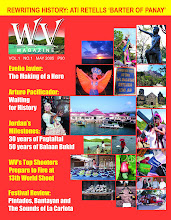Home
By Jo Martinez-Clemente
Philippine Daily Inquirer
First Posted 22:25:00 05/10/2008
Filed Under: Economy, Business & Finance
SIBALOM, Antique -- “Golden wishes do not grow on trees,” says an old scouting song, but jade, jasper and onyx do.
Called gem trees, these are produced by a farmer in this town who goes by the monicker “batologist.”
When he started scouring the riverbeds that embrace Mt. Porras here—picking tiny stones left and right and throwing back some, here and there—people had thought this man was one “unfortunate soul” who needed psychiatric help.
That was more than 10 years ago when Leovic Gellangarin, a 54-year-old farmer from Barangay Iglanot was still learning about semiprecious stones that lay abundant in his town of Sibalom.
Today, Mang Leo runs a backyard business of stonecraft producing a variety of items—from pendants to home decor made of these gems from the river.
‘Batologist’
Today, he is regarded as the towns’ “batologist,” being a disciple of Sibalom’s acknowledged gemologist, Florentino Esponilla.
Mang Leo says his enchantment with precious stones was sparked in 1994 when he met Esponilla in the province’s capital town of San Jose during a stonecraft demonstration mounted by the provincial government, the Department of Science and Technology and the MIRDC Machine Designs.
There, Mang Leo says, he watched Esponilla grind, cut and polish the stones to bring out their natural shine. Before he knew it, he was already deep into learning the different types of gemstones that form part of Antique’s rich natural resource.
Mang Leo looks at Esponilla as the Father of Sibalom’s Gemology, saying that he was the first to know and learn about the gemstones.
Driftstone, sei seki, gem trees
Under the label “Mr. Gemstone Craft,” Mang Leo’s items include gem trees, paperweights, mosaic, souvenir and collector’s items and pendants.
He, however, takes pride in creating an item he calls the “driftstone,” a new art form he invented, he says, that makes use of “powdered” gemstones that are embedded into driftwood.
He also says he has become an expert in sei seki—a Japanese term that means water and stone, but he uses it to identify stones he was able to gather that were “carved by water” to form various things like animal figures, islands and even color-abstracts.
Mang Leo explains that he has mastered the art of “reading the sei seki and seeing something in the stone’s natural form.”
For instance, a heart-shaped blue colored stone was fashioned into a pendant.
He says his most popular item is the gem tree. He shapes the gems into leaves and flowers and he fashions them into “trees” of different shapes and sizes using a design machine he made himself.
Mang Leo says he gets inspiration from bonsai plants. As the entire process is very delicate and intricate, it takes him a day to finish a medium-sized gem tree.
Price depends on the kind of gemstones the tree is made of. A medium-sized gem tree that is about 8 to 6 inches in height made of white jade would cost around P3,000. A smaller size of the same kind would go for about P1,200.00.
Mini trees for office tables that would have just a couple of branches and a few leaves would cost between P100 and P200.
Mang Leo says people buy his gem trees for different reasons but most buy them for luck.
Tektite wish
Mang Leo says his goods are yet to find national exposure as he has yet to join a trade fair in Manila. But he has already made inroads into the local market as once a month he gets invited to participate in trade fairs in Iloilo City.
Mang Leo knows that the rivers surrounding Mt. Porras—like Imparayan river where he gathers his gemstones—are within the Sibalom Natural Park, a biodiversity conservation area, but he stresses that people are allowed to gather stones in the area.
What is forbidden, he says, is outright extraction or quarrying.
The one stone he has kept for himself is a wishing stone called tektite.
And with his tektite wishing stone, Mang Leo’s wish is for government to help more entrepreneurs who want to further refine their craft and improve their business.
http://business.inquirer.net/money/topstories/view/20080510-135771/Growing-gem-trees-from-Sibaloms-riverbeds
Cara Pengobatan Penyakit Kondiloma Akuminata Tanpa Operasi
-
Apa Itu Penyakit Kondiloma Akuminata ???Penyakit Kondiloma Akuminata ialah
vegetasi oleh Human Papiloma Virus tipe tertentu, bertangkai, dan
permukaannya b...
10 years ago



No comments:
Post a Comment